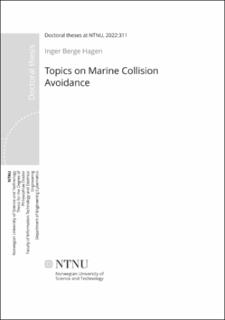| dc.description.abstract | The increasing number of both industrial and academic initiatives towards maritime autonomy is a clear indication that this is an active and rapidly expanding field. This thesis presents developments contributing to the future realization of autonomous surface vehicles (ASVs), and is divided into three parts according to the topics treated. The first part is dedicated to the tracking of kayaks in urban environments, while the second and third part concerns the development and evaluation of collision avoidance algorithms. The red line that connects these topics is found in the thesis’ main objective, namely to contribute to the ability of ASVs to safely navigate waters shared with vessels under conventional human control.
Part one of the thesis applies this objective to the field of target tracking . The result is a method for extended object tracking (EOT) that employs measurements from a light detection and ranging (lidar) sensor to track the movements of a kayak. Kayaks are small, narrow vessels and kayaking is often practiced on urban waterways as a means of exercise or decompression. The choice of target model was brought on by the fact that easy access to existing infrastructure in metropolitan areas has framed these as one of the prime locations for the early deployment of autonomous vessels. Such applications has triggered the need for research on novel tracking methods capable of handling the distinct environments and vessel types of such locations, to which this work contributes.
While the first part of the thesis focuses on the ASV’s ability to sense and interpret its surroundings, the second and third part are dedicated to assuring that it reacts to this information in an appropriate manner. This includes the development of a collision avoidance algorithm designed to produce behaviors that adhere to the International Regulations for Preventing Collisions at Sea (COLREGs). Achieving this is crucial for ASVs ability to interact safely with vessels operated by humans and thus an important step towards future deployment. The presented method is also easily integrated into existing guidance and control systems currently in use on marine vessels, which allowed for the execution of the on-water experiments presented in this part.
Also presented is a method for evaluating the behavior produced by collision avoidance algorithms. This contribution can be seen as a tool in the process of refining existing algorithms, capable of identifying problematic behaviors from simulated trajectories without the need for manual inspection. It can also be viewed in the context of system verification for ASVs, where such methods will be an important element.
The work on evaluation is complemented by a study into the collision avoidance behaviors displayed by conventional maritime vessels in normal operation. This was motivated by the need for more well defined criteria for COLREGs compliant behavior, both with respect to the evaluation process, but also for the collision avoidance algorithms themselves. The term COLREGs compliant is commonly used to describe algorithms that comply with the qualitative behaviors prescribed in Rules 13-17, sometimes also including parts of Rule 8. However, many of the rules allude to the use of human judgment, for instance when stating that vessels should pass each other at a safe distance, or that maneuvers should be readily apparent to the other vessel. The inclusion of such considerations in collision avoidance algorithms require a formal definition in terms of parameters and numerical values, along with their dependence on situation specific factors and parameters. While this requirement could not be fully met, the study does give useful insights into what factors may influence vessel behavior along with a presentation of the statistics obtained.
In addition to the chapters on the topics mentioned above, this thesis includes an introductory chapter aimed at giving a deeper understanding of the motivation behind the presented work, along with some relevant background and context regarding the contributions. The concluding chapter is dedicated to summarize the achieved outcomes and outlines possible directions for future exploration. | en_US |
